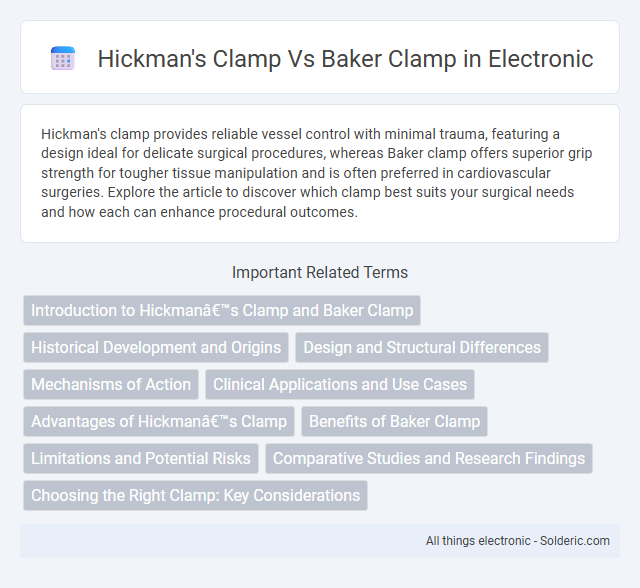Hickman's clamp provides reliable vessel control with minimal trauma, featuring a design ideal for delicate surgical procedures, whereas Baker clamp offers superior grip strength for tougher tissue manipulation and is often preferred in cardiovascular surgeries. Explore the article to discover which clamp best suits your surgical needs and how each can enhance procedural outcomes.
Comparison Table
| Feature | Hickman's Clamp | Baker Clamp |
|---|---|---|
| Primary Use | Used for temporary vascular occlusion during surgery | Commonly used for clamping vessels and tubular structures |
| Design | Curved with smooth, narrow jaws for delicate vessel handling | Straight or slightly curved jaws designed for firm grip |
| Jaw Type | Smooth, atraumatic jaws | May have serrated jaws for enhanced grip |
| Material | High-grade stainless steel | Stainless steel, often with tungsten carbide inserts |
| Locking Mechanism | Ratchet lock for secure positioning | Ratchet lock with adjustable tension |
| Common Surgical Fields | Cardiovascular, thoracic surgeries | General surgery, microvascular procedures |
| Size | Varies; typically medium size for vessel occlusion | Available in multiple sizes for versatility |
Introduction to Hickman’s Clamp and Baker Clamp
Hickman's clamp and Baker clamp are specialized surgical tools designed to control blood flow during procedures by providing secure vessel occlusion. The Hickman's clamp is known for its precise grip and adjustable tension mechanism, making it ideal for delicate vascular surgeries. In contrast, the Baker clamp features a robust design with serrated jaws, offering reliable and stable vessel clamping for broader surgical applications. Your choice between these clamps depends on the specific requirements of vessel size and surgical precision needed.
Historical Development and Origins
Hickman's clamp, developed in the early 20th century, emerged as a specialized surgical tool designed to provide secure vessel occlusion during complex cardiovascular procedures. The Baker clamp, introduced slightly later, gained prominence for its refined mechanism and ease of use in thoracic surgeries, marking a significant advancement in surgical instrumentation. Both clamps reflect the evolution of surgical technology, with Hickman's design rooted in the demands of early cardiac surgery and Baker's improvement emphasizing maneuverability and precision.
Design and Structural Differences
Hickman's clamp features a scissor-like design with a straight, narrow jaw optimized for vascular access and minimal vessel trauma, while the Baker clamp has a sturdier, angled jaw providing a firmer grip for thicker or more fibrous tissues. The structural difference lies in Hickman's lightweight, delicate construction suited for fine vessel manipulation, contrasting with Baker's robust build designed to control tougher tissue structures. Hickman clamps often include a ratchet mechanism for precise control, whereas Baker clamps prioritize enhanced jaw strength and angulation for secure clamping.
Mechanisms of Action
Hickman's clamp operates by applying uniform pressure to occlude large veins, primarily used in central venous catheter placement to prevent blood flow during insertion. Baker clamp features a ratcheted, serrated locking mechanism that securely clamps delicate vessels or tissue edges without causing excessive trauma, often utilized in orthopedic and cardiovascular procedures. Both clamps function by mechanically restricting blood flow, but Hickman's design emphasizes atraumatic vein compression, whereas Baker clamp offers precise control for tissue manipulation.
Clinical Applications and Use Cases
Hickman's clamp is primarily designed for securing and controlling central venous catheters during long-term vascular access, making it ideal in oncology and dialysis settings. Baker clamp offers precise vascular or soft tissue occlusion in microsurgery and delicate procedures, ensuring minimal trauma to surrounding tissues. Your choice between these clamps should consider the specific clinical application, such as Hickman's for catheter management versus Baker for fine surgical manipulations.
Advantages of Hickman’s Clamp
Hickman's clamp offers superior control and stability during vascular procedures, reducing the risk of vessel damage compared to the Baker clamp. Its ergonomic design allows for precise maneuvering, enhancing surgical efficiency and patient safety. You benefit from improved hemostasis and minimized tissue trauma, making Hickman's clamp a preferred choice for delicate vessel clamping.
Benefits of Baker Clamp
The Baker clamp offers superior control and precision in maintaining vessel integrity during microsurgical procedures, reducing the risk of tissue trauma compared to the Hickman clamp. Its ergonomic design provides enhanced stability and ease of use, allowing you to perform delicate vascular anastomoses more efficiently. Improved clamping pressure distribution with the Baker clamp also minimizes vessel wall damage and supports optimal surgical outcomes.
Limitations and Potential Risks
Hickman's clamp poses limitations such as less precise control in delicate vascular procedures and a higher risk of vessel damage due to its bulkier design. Baker clamps, while offering finer control and reduced trauma due to their slimmer profile, carry potential risks including slippage if not properly secured and increased pressure on fragile tissues. Both clamps require careful selection based on vessel size and procedure type to minimize complications like thrombosis or tissue ischemia.
Comparative Studies and Research Findings
Comparative studies between Hickman's clamp and Baker clamp highlight differences in efficacy and safety during surgical procedures. Research findings indicate Hickman's clamp offers superior precision in vascular control, while Baker clamp provides enhanced ease of use in microsurgical applications. Your choice should consider the specific clinical context and surgeon's proficiency to optimize patient outcomes.
Choosing the Right Clamp: Key Considerations
Selecting between Hickman's clamp and Baker clamp depends on factors such as the specific surgical application, vessel size, and desired occlusion precision. Hickman's clamp offers fine control for delicate vessels, while Baker clamp provides robust grip for larger vessels or tougher tissues. Your choice should align with the procedure's requirements to optimize outcomes and minimize tissue trauma.
Hickman's clamp vs Baker clamp Infographic

 solderic.com
solderic.com